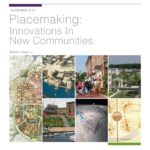Volume 40, Number 1
Published: Spring 2015
Reviewed by Peter C. Burley, CRE
 Placemaking: Innovations in New Communities
Placemaking: Innovations in New Communities
by Mahlon ‘Sandy’ Apgar IV, (ULI, 2014), 35pp, with Appendix
Mahlon ‘Sandy’ Apgar IV, CRE, joins a continuing discussion on the effort to create healthier, sustainable living environments that enhance the social and economic well-being of those who reside within them. The literature has been fairly extensive, particularly over the past couple of decades, and not without controversy and debate throughout the planning and real estate communities. Tomes have been written on the subject of Master Planned Communities, Smart Growth, and New Urbanism, including a large number of ULI’s publications, from Bohl’s Place Making: Developing Town Centers, Main Streets, and Urban to Mixed-Use Development Handbook, 2003, by Dean Schwanke, to Massengale and Dover’s Street Design: The Secret to Great Cities and Towns (2013), and a host of others.
The discussion (not always civil) continues as planners and developers argue about what homebuyers and community residents really want – McMansions in the automobile-dependent suburban expanse or more modest accommodation in a walkable community. As recently as this past February (2015), in an article published in the Atlantic, Alena Semuels notes that urban planners and “smart growth” advocates (argue) for a drastic change in homebuilding – calling for more compact homes in walkable communities … located near public transit. Doing so, they argue will jump-start the housing market since that’s what home buyers say they want.1 At the same time, it is clear that the home “building industry has been incredibly resilient at resisting change,” according to Smart Growth guru Christopher Leinberger,2 a senior fellow at the Brookings Institution.
In an era of massive global urbanization brought by dramatic demographic changes, economic upheaval, and environmental challenges, the discussion is of critical importance to today’s planners and real estate practitioners. With the rise of the Millennial Generation, which clearly prefers a walkable urban setting, and the imminent downsizing of the Baby Boomers, the push and pull between the suburbs and the urban core becomes ever more important. A recent Nielsen study reinforces that notion, noting that “Millennials are fueling an urban revolution looking for the vibrant, creative energy [of] cities offering a mix of housing, shopping and offices right outside their doorstep. They’re walkers and less interested in the car culture that defined Baby Boomers.”3 As suburban developers now look to create “urban ‘burbs” with more “urban” attributes, including walkable downtown areas, transit-friendly areas, and mixed housing types, the New Community concept is gaining new visibility and viability and is becoming much more common practice. It is here that Apgar’s extensive experience is of immense importance, and notability, as he draws on his personal experience studying British New Towns; working with James Rouse in the development of Columbia, Maryland; serving on the ULI New Communities Council; and, co-founding the International New Towns Association. Few others can speak with the experience or the authority that Apgar brings to the discussion. But, he does not stop with his own experience. Apgar surveyed more than 700 professionals in the Counselor, RICS, and ULI communities and among the National Town Builders Association, the Royal Town Planning Institute and the Town and Country Planning Association. He interviews some 20 high-level active professionals from a variety of stakeholder interests as well. Apgar focuses on two types of New Communities: “Greenfield,” developed where land is plentiful and inexpensive, that can serve as “antidotes to the high land consumption and infrastructure costs of single-family tract housing”; and smaller and denser “Urban Renaissance,” developed within cities, often to “correct negative effects of earlier policies” and to “propel improvements” or “increase utilization of underdeveloped land and buildings.” From his surveys and interviews, Apgar compiles findings that result in a set of Innovations that emerge from the New Community experience and a set of Initiatives. Innovations include: Comprehensive Plans, Portfolio Economics, Integrative Business Models, Public-Private Partnerships and Resident-Driven Services. Initiatives include: Prime Movers (using New Communities as generators of responsive urban growth; through partnerships with various key entities), Information and Analytics, Unconventional Uses, Community Designs, and Investment Funds. He discusses each aspect in detail, offering examples and case studies. Case study examples and sidebars are scattered throughout, while two detailed examples (“Caselets”) of New Communities are included in the publication: Columbia, Maryland and the Residential Communities Initiative (RCI) at Fort Belvoir, Virginia.
Apgar considers the publication “a work-in-progress on a topic of profound importance for policymakers and practitioners.” I could not agree more. Planners and policymakers will need to reach out proactively to deal with social, demographic and economic changes. And, practitioners will need to grasp some of the changing needs of those who consume their products and services, being somewhat less resistant to change. In his concluding note, Apgar draws three conclusions (no spoilers here): 1. New Community Developers are not only seers; they also seek to improve our built environment; 2. New Community Development is not formulaic, although management principles can be codified and decision-makers can apply them to the challenges of urbanization; and, 3. Innovation is not a choice for New Communities Developers – it is a must. The report itself is short, just 35 pages, but it is thorough, professional and filled with Sandy Apgar’s unique perspective guided by experience and wisdom. The Appendix, which runs a little over 100 pages is loaded with specific survey results and data and would draw an interested researcher’s attention for a solid afternoon. All in all, a great read on an important subject.





